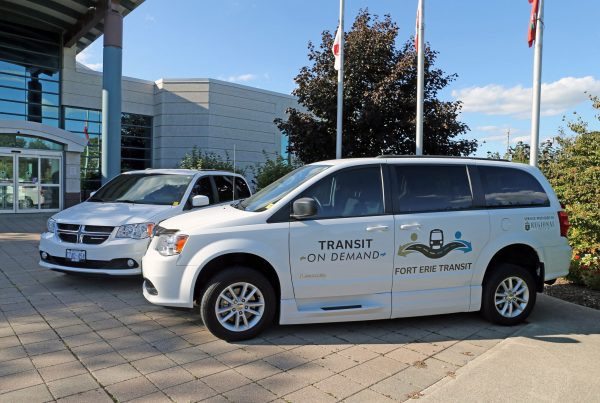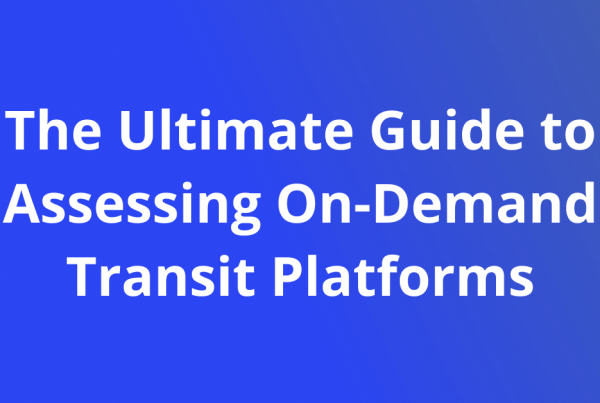When we think of big infrastructure projects we tend to imagine people in hardhats lining up with shovels, standing in front of a pile of dirt for a photo-op, or a similarly contrived scene at a ribbon cutting ceremony. Politicians like construction of physical things that they can drape with bunting and point to, years later, as evidence of their ability to “get things done”. There is however, a forgotten area of infrastructure that does not need shovels and has nothing to drape bunting on but it will have an impact on the lives of millions of people and on the wallets of taxpayers. This is the software infrastructure of our transportation systems; which represents a gigantic opportunity to improve people transportation. What is software infrastructure? In this context it is simply the technology systems used by people transportation providers on a large geographic scale to help control and provide their service.
 In America, there is $200 billion for transportation infrastructure up for grabs in November 8th ballot initiatives. The expenditure of fresh investment on physical transit infrastructure is a hot topic everywhere. A light-hearted example was a recent competition to find the “sorriest bus stop in America” demonstrating the rising public consciousness of transit infrastructure. While attractive and accessible bus stops are important, recent surveys of transit users by the Transit Center shows that overwhelmingly people care about frequency of service and walkability to and from service. The question becomes, how can we invest in transportation in a meaningful and politically viable way with the greatest possible impact on the metrics that actually matter to people?
In America, there is $200 billion for transportation infrastructure up for grabs in November 8th ballot initiatives. The expenditure of fresh investment on physical transit infrastructure is a hot topic everywhere. A light-hearted example was a recent competition to find the “sorriest bus stop in America” demonstrating the rising public consciousness of transit infrastructure. While attractive and accessible bus stops are important, recent surveys of transit users by the Transit Center shows that overwhelmingly people care about frequency of service and walkability to and from service. The question becomes, how can we invest in transportation in a meaningful and politically viable way with the greatest possible impact on the metrics that actually matter to people?
Here is another way of looking at our transportation infrastructure, think of the software that controls it, especially what controls the vehicles and interactions with riders. Since the release of smartphones in 2007 the world of transportation has been in an ongoing process of disruption and change. Starting with the slow demise of taxis and the rise of transportation network companies these changes are flowing into all sectors of transportation.
Consider the example of medical transportation. The Federal Transit Administration just gave a $7 million dollar grant to develop the “Innovative Coordinated Access and Mobility” which will help connect people to much-needed healthcare services through improved access to public transportation. The grant will include disbursements of money to municipalities to develop and deploy software to coordinate transportation to and from medical appointments. To take this to a more human level, one of the municipalities granted this money is Flint Michigan, which is still reeling from a public health crisis after its main source of drinking water was contaminated.
Here is the basic logic of investment in software infrastructure. When money is spent on a new bus stop, for example, there is an improvement to service quality. But the benefit is limited to that one geographic point where the money was spent. Things like: better bus stops, extra buses and new facilities, etc. These are all great investments and we are not suggesting to stop spending on them. But based on the amount of effort and expense, what will be the cause of the most transformative and beneficial results to the service as a whole and on what scale can the results be realized? Software allows a whole new scale of impact for investments and it scales quickly, Uber covered the globe in about five years because of a software based model. An application that you develop once can be installed on a limitless number of phones, and one system could potentially manage an entire region, state, or continent. A government could spend a lot of money to improve a number of bus stops, and the people that happen use them will have a marginally better experience, or there could be one investment into technology that could change an entire public transportation system for every single one of its users and also for its operators.
 This is what Pantonium wants to do. Build a software infrastructure to collect real time data. Get the ridership demand and also the operational data: the routes, schedules, the vehicle locations; and then optimize everything. What does this mean? Take the data and feed them into an algorithm to determine a better way to schedule and route vehicles during everyday operations. Do that in real time and suddenly transit is a responsive and efficient service that can adapt to demand. Riders would only provide this valuable information if they knew they were getting something out of it, and what they get is control, which is something that public transit operators could not offer before. For riders who have long been trodden upon by arbitrary bus routes and schedules that never change and never serve their needs, there would be an opportunity to have an input and a say about when and where the bus comes. This would be done in the reality of everyday operations, not in occasional bureaucratic meetings in city hall backrooms.
This is what Pantonium wants to do. Build a software infrastructure to collect real time data. Get the ridership demand and also the operational data: the routes, schedules, the vehicle locations; and then optimize everything. What does this mean? Take the data and feed them into an algorithm to determine a better way to schedule and route vehicles during everyday operations. Do that in real time and suddenly transit is a responsive and efficient service that can adapt to demand. Riders would only provide this valuable information if they knew they were getting something out of it, and what they get is control, which is something that public transit operators could not offer before. For riders who have long been trodden upon by arbitrary bus routes and schedules that never change and never serve their needs, there would be an opportunity to have an input and a say about when and where the bus comes. This would be done in the reality of everyday operations, not in occasional bureaucratic meetings in city hall backrooms.
This type of investment must be made by almost all public transit authorities in North America. Service is not keeping up with growth of demand or population. As found by a recent ITDP study, on the percentage of “people near transit” the number of people actually close to reliable transit is shocking:
“For the 13 cities in industrialized countries that were scored, the average people near transit (PNT) was 68.5%, while those cities’ metropolitan regions averaged 37.3%. The metro regions of the six US cities averaged a score of 17.2%.”
That statistic means the transit infrastructure of North America’s large metropolitan areas covers far less than half the actual population. The current paradigm of investment has clearly failed, we need a new way to increase access to transit. That is why software is key. It is quick to deploy, and when it comes to people transportation, it can have a huge impact on the scale and coverage of a service. So the next time there is an astronomical sum being allocated to infrastructure, ask how much will be spent on the technology that manages and connects riders with the vehicles. Ask for a new transit software system, designed with 21st century technology, and a mindset to improve efficiency and flexibility, and deployed on the scale to completely cover our metropolitan regions. This would be something worth the expenditure and also something worth putting some bunting on.
Image 1: A Fine Line / Frederic Geurts
Image 2: Circuit Computer Chip / www.bluecoat.com
Image 3: Boston at Night / Betsy Weber




